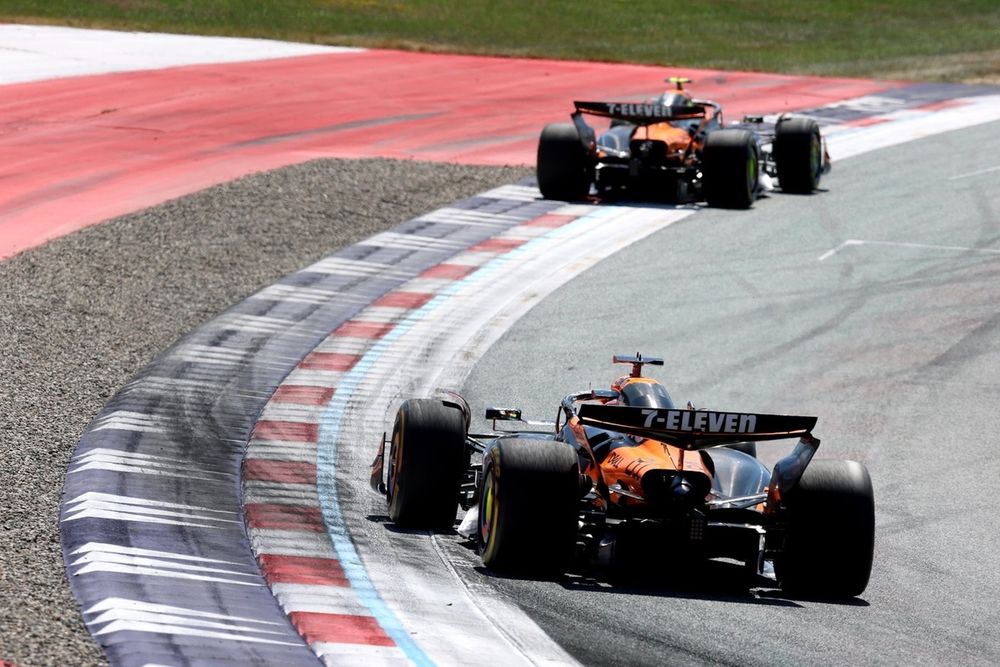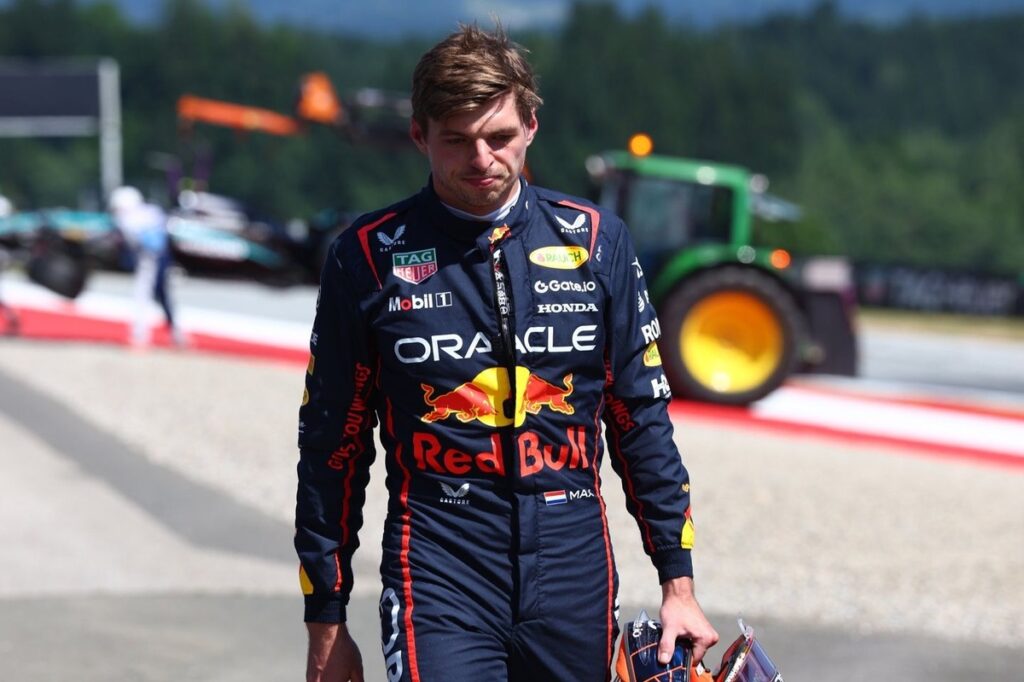“We still have some updates for the next two races, but a performance like this forces us to write off the championship,” said Helmut Marko after the Austrian Grand Prix.
“A performance like this” referred to McLaren’s dominance, but Marko’s words could easily apply to Red Bull itself. The team’s showing at its home track in Spielberg was not what it had hoped for. Or, as Christian Horner said at the start of his post-race media session: “Well, that was a home race to forget…”
The yellow flag caused by Pierre Gasly during qualifying and the hit from Andrea Kimi Antonelli on the opening lap of the race didn’t help, but the real story goes beyond those incidents. Max Verstappen was the first to acknowledge that after the race. Speaking in the media pen, he was fairly forgiving of Antonelli: “Every driver has made a mistake like that. Kimi is a great talent, he’ll learn from this.”
Just like on Saturday, Verstappen didn’t use any excuses and focused on Red Bull’s own performance: “I had a bit of bad luck in qualifying yesterday, and also in the race today, but if you look at the whole weekend, we’re simply not where we want to be.”
Red Bull lacking in three key areas compared to McLaren
That statement applies on multiple fronts. Red Bull is still lacking outright pace: Marko estimated a 0.3s gap over a flying lap and around half a second per lap during race runs.
That’s one problem, but far from the only one. The RB21’s operating window is still extremely narrow, as the weekend in Spielberg has shown once again. The Red Bull car seemed competitive in the cooler FP3 conditions after set-up changes, but struggled considerably in the warmer qualifying session. As Verstappen put it: “Everything just fell apart.”
Max Verstappen, Red Bull Racing
Photo by: Zak Mauger / LAT Images via Getty Images
It makes Red Bull’s situation more complex. The two issues – raw pace and a small operating window – are interconnected. As technical director Pierre Wache explained last winter, widening the car’s set-up window could compromise its overall potential: “As an ideal world, sure, you’d want both things. But you know that the overall potential of a car can get lower if you widen the window.” Waceé added that it would be best to find the ideal set-up window for each circuit, but the heat in Austria proved that’s easier said than done.
The result is that McLaren not only has a faster car in terms of peak potential, but also a much broader window to use that potential. Solving both issues within just a few races is nearly impossible – despite more of Red Bull’s new floor package arriving in Silverstone and another update scheduled for Spa.
And then there’s a third factor: tyre management. McLaren holds a clear edge here too – possibly the biggest of all. This was noted by both Marko and Horner as the most revealing aspect of the Austrian GP.
“What’s truly impressive, and for me, I can’t see any other team being able to do it, is when you look at how close Oscar is able to run behind Lando with a car fat on fuel at the beginning of the race. He’s basically making love to his fucking exhaust pipe for lap after lap after lap, and the tyres are not dying. That to me is their advantage.”
Horner ended his answer with words that might be the most telling: “I don’t really understand.” Red Bull still doesn’t fully grasp how McLaren manages its rear tyres so effectively, even after studying thermal images of the brake ducts. Marko expressed a similar sentiment outside the team’s hospitality area: “What they’re doing in high temperatures, that’s something we’ve puzzling over for a while now.”
In truth, there is a fourth factor: the 61-point gap in the championship standings, more than two DNFs worth of margin for Oscar Piastri, so Marko’s conclusion makes perfect sense. Especially since the issues mentioned are complex and not easily solved, as Horner acknowledges as well: “There is no silver bullet in Formula 1. Progress takes time.”
This makes a 2025 turnaround virtually impossible, especially with the 2026 regulations looming in the background.

Lando Norris, McLaren, Oscar Piastri, McLaren
Photo by: Steven Tee / LAT Images via Getty Images
What does this say about Red Bull?
The bigger question is what this says about Red Bull long-term. Regarding McLaren’s tyre advantage, team principal Andrea Stella noted in Miami that some knowledge about rear tyre management can carry over to next year, despite the new cars and new tyres. Horner, however, doesn’t believe Red Bull will carry that disadvantage into 2026: “26 is like comparing football and rugby at the moment. It’s played on the same field, but the rules are completely different.”
Still, the question remains: what does Red Bull’s current struggle say about the team’s long-term outlook? Since Miami last year Red Bull’s technical team has not been able to reverse the situation. That matters, regardless of the regulations, also for Verstappen’s perception. Horner said the team is “fully aware of the situation with Verstappen and the contract,” but has often stated he doesn’t want to keep a driver against his will with just a piece of paper. “That’s correct,” he confirmed again in Austria.
It leads to the bigger follow-up question: is Red Bull in its current state able to turn this around, regardless of regulation changes? “I still believe that we have strength and depth in this team, that unfortunately we haven’t seen the performance come from that we would like,” Horner replied. “We’re at the end of a set of regulations. I think we are compromised by some of the tools that we have,” referring specifically to the outdated wind tunnel. “But it’s the same fundamental group of people that 18 months ago had designed a car that won every grand prix but one. They didn’t suddenly become idiots overnight.”
Having said that, it’s still crucially important to show progress – especially to keep Verstappen onboard. If 2025 has to be written off and ends without a title, there are still question marks heading into 2026 about both the new power unit and the rest of the team.
The good news: Red Bull believes its old wind tunnel is still good enough to handle the first major development steps under a new set of regulations. In that sense, the tools may be less of a limitation than they are now. But as Adrian Newey rightly pointed out in Monaco: “At the end of the day, it’s not the wind tunnel that makes the difference. It’s the human aspect; the design you feed into it.”
In that light, these months are still important, especially if Red Bull wants to retain Verstappen long-term. And given the ongoing struggles with the second seat, that’s something the team should want at all costs. The Austrian GP might have offered a glimpse of what Red Bull looks like without Verstappen. The team has become heavily reliant on the reigning world champion, meaning that retaining his full trust might be the most important aspect of 2025. And that goes beyond a costly hit from Antonelli or an unlucky yellow flag indeed.
In this article
Ronald Vording
Formula 1
Max Verstappen
Helmut Marko
Christian Horner
Red Bull Racing
Be the first to know and subscribe for real-time news email updates on these topics
Subscribe to news alerts
Read the full article here

